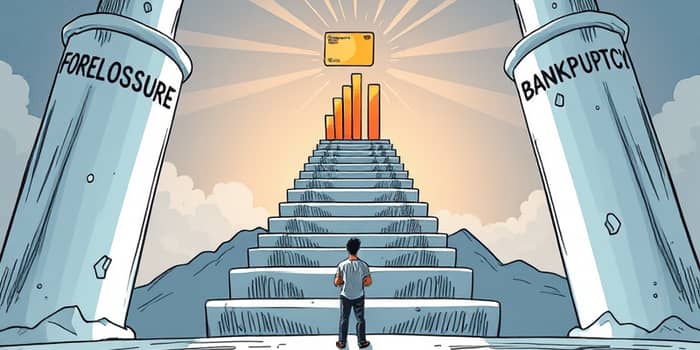
Recovering from both foreclosure and bankruptcy can feel like climbing a steep hill, but with patience and clear strategies, you can rebuild your financial standing.
This guide offers a comprehensive journey through the impacts, timelines, and proven steps to secure a credit card after significant financial setbacks.
When a foreclosure hits your report, it creates a major drop in credit score—often over 100 points. A 680 score may fall by 85–105 points, while a 780 score can decline by 140–160.
Bankruptcy compounds that challenge. Chapter 7 filings remain for 10 years, and Chapter 13 stays for seven, each drastically curbing access to new credit.
In the initial months, these negative marks carry their heaviest weight, then gradually lessen as timely payments and positive entries begin to balance your profile.
Before mapping your recovery plan, know the official timeframes for public records on your credit report.
These durations reflect the maximum lifespan of each record. Proving responsible behavior, however, can help you achieve a favorable score well within those windows.
Every positive action you take adds a new layer of credibility to your credit profile. Consider these foundational tactics:
A secured credit card deposit typically ranges from $200 to $500, matching your credit limit. As you pay on time, issuers report this responsible behavior to the bureaus.
Credit-builder loans, often $300–$1,000 over 6–24 months, act like a savings account: you borrow against your own locked-up funds and receive them only once you’ve demonstrated steady payments.
You become eligible to apply as soon as your bankruptcy is filed, but the smartest approach is to wait for discharge—usually 3–5 months after Chapter 7 filing—to access better offers.
In a Chapter 13 plan, trustee approval is required, and limits will be low, typically mandating full monthly repayment.
Many consumers start receiving offers within one to two years of filing, though initial deals often carry APRs above 20% and minimal credit lines.
As you rebuild, you may be targeted by predatory lenders offering too-good-to-be-true terms. Read all disclosures and fee schedules carefully.
Always avoid credit repair scams that claim to erase valid public records—only time and solid payment history can remove those recourse marks.
If you feel overwhelmed, work with a reputable credit counseling agency. A certified counselor can help you set budgets and negotiate with creditors.
While foreclosure and Chapter 13 bankruptcies fall off after seven years and Chapter 7 after ten, your credit score can rebound far sooner.
Focus on gradual and consistent progress—building a two-year track record of on-time payments often opens doors to conventional credit products like auto loans and mortgages.
Keep your balances low, limit new hard inquiries, and consider goodwill letters to lenders for any past late payments. Small wins—like a credit limit increase on a secured card—signal to bureaus that you’re a lower risk.
By maintaining patience, persistence, and responsible habits, many individuals reach a “good” credit score (670–700+) within three to five years, long before negative marks disappear.
Your path from foreclosure and bankruptcy to financial stability is a marathon, not a sprint. With each payment, each report check, and each responsible decision, you lay the foundation for a stronger future.
References













